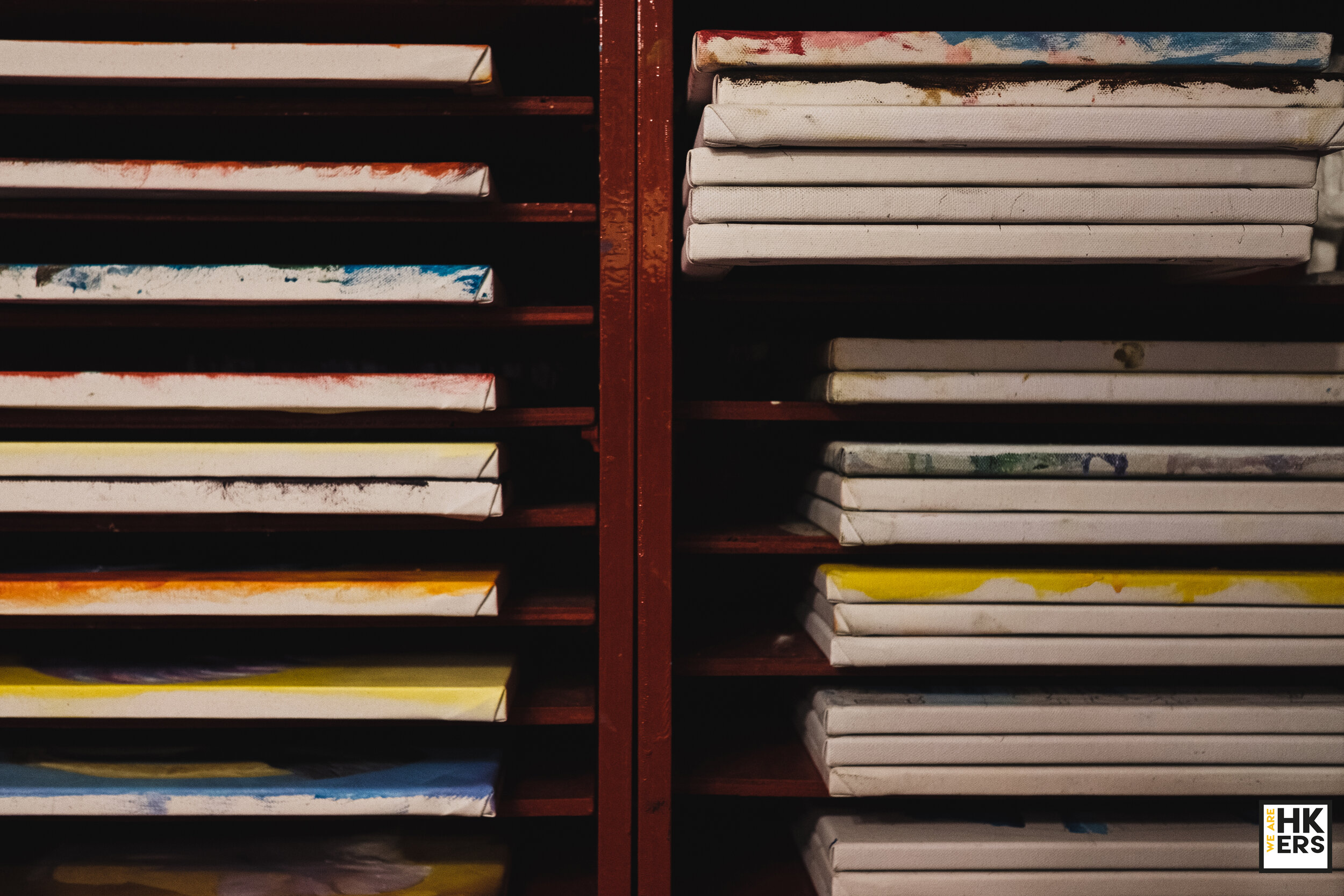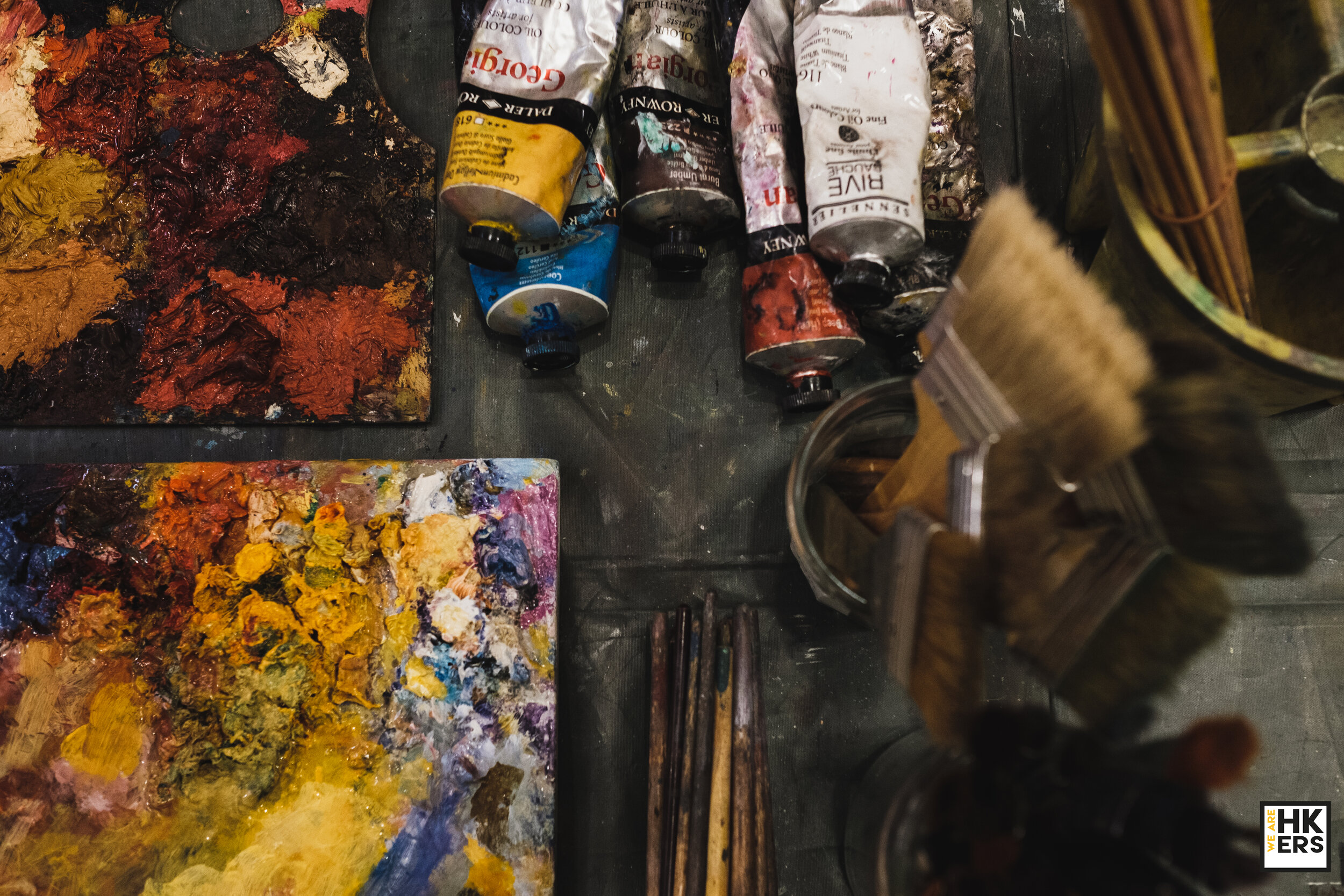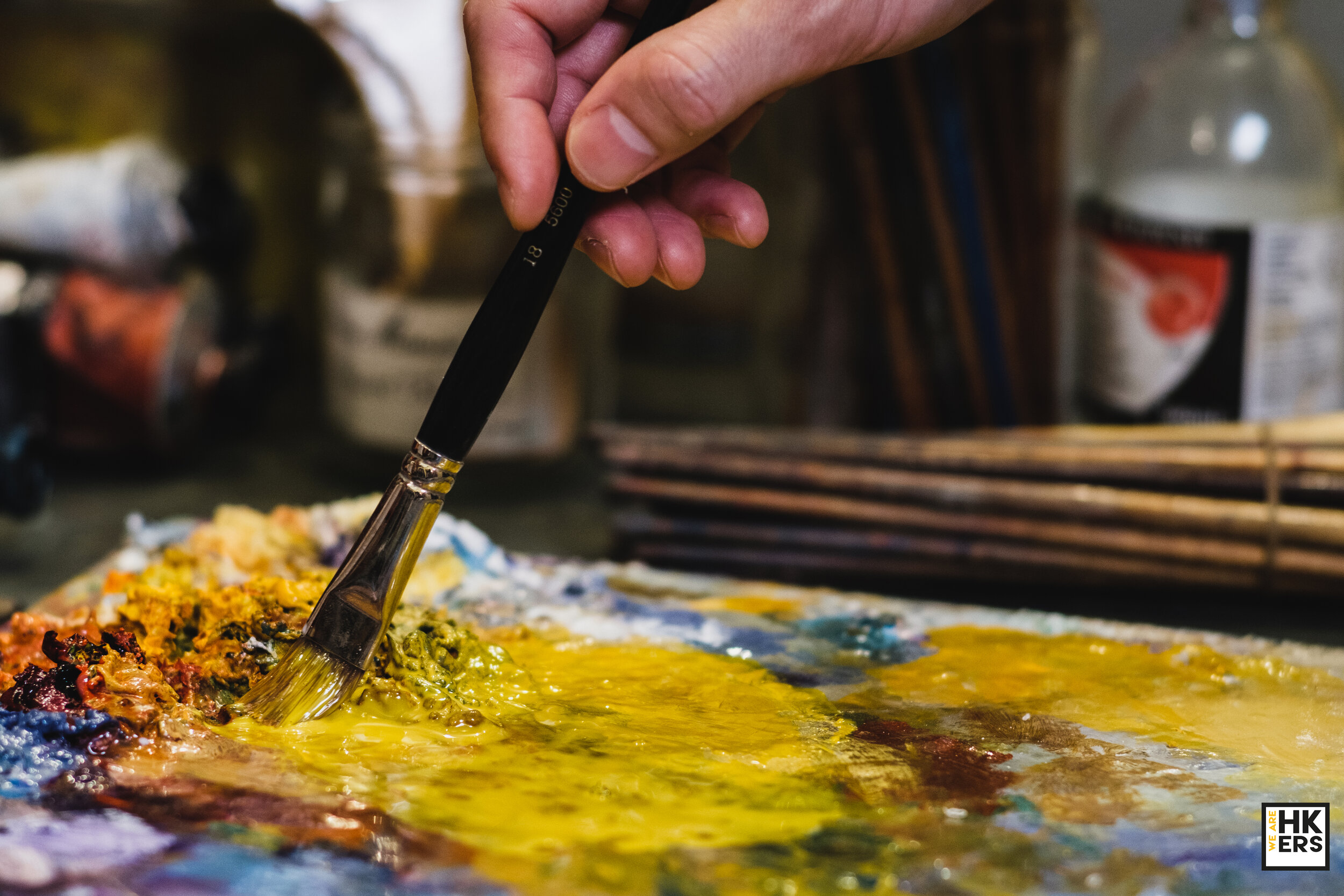【Video】LumliLumlong | The discipline, therapy and power of art
LumliLumlong are local Hong Kong artists. Their shocking artwork brings about reflection. The two artists care deeply about society and hope to convey a realistic side of Hong Kong society through their artwork.
“If everyone had this fixation with beauty intrinsically and applied the principles of creating a good drawing to improving their lives, society might become different. ”
Journalist: King Kenny
Translator: Zucchhi
Videographer: Just.Production
Video Editor: Tim
Photos: Just.Production
Editorial: ABoyNamedFlora, Fuigei, Flore Herbe
Production: Onehungrycoconut, JM
The birth of a piece of artwork
To us, a full of local Hong Kong characteristic cha caan teng is a cradle of inspiration. We draw sketches on paper napkins which marks the beginning of our idea conception and creation. Artistic style can realistically reflect our true selves. From the colours to the lines, they all reflect whether the artist is intuitive or rational. For example, Lumli’s style is more colourful with more textures and focuses on love and hope. Lumlong likes darker colours and smoother lines, with themes of justice and judgment. Although we sometimes argue, we enjoy this process of discussion and negotiation because we end up understanding each other better. Our styles are becoming more and more similar and we complement each other. We often joke that we can even achieve democracy through art. We communicate and listen to each other, seeking commonalities amongst differences.
The inspiration for one of our pieces titled Zipper Man comes from the 2011 case of Yueyue, a two-year-old girl in Foshan who tragically died due to the indifference of passersby. After discussion, we decided that Lumlong would draw the passerby and Lumli would draw the scavenging grandma who tried to save her. We have different interpretations of the zipper between them. LumLong thinks that it is a metaphor of a torn system while Lumli thinks that it is reparation out of love. Different people may have different interpretations, but all enrich and complete the story.
Artistic Style
In the early days, our art was quite influenced by the medieval style. The Middle Ages was an era passionate about religion. Artistic creation was not meant for entertainment or self-fulfilment, but rather a process for self-cultivation. The condition of the soul could be seen through artwork, presenting the condition of marginalities of life and the imagination for death. We remember when we were still studying in France and would often walk through The Louvre. The lower levels had a lot of medieval exhibitions such as paintings of saints which gave us a solemn feeling, and we were in awe every time.
After we returned from France, we had financial difficulties as it’s not easy to be financially sustainable in the art industry. The predominance of Hong Kong’s real estate industry doesn’t help either. There were many elderly ladies scavenging paper waste for resale in our old neighbourhood of Sai Wan. Witnessing the changes in our community and the difficulties of the grassroots, we asked “why?” at first, but slowly started to delve deeper into people’s livelihood issues and further studied societal politics.
Even though we have artwork related to 4 June 1989, in the end, it’s not our personal experience and it doesn’t count as a local issue. Our greatest awakening was the Anti-Hong Kong Express Rail Link Movement [*1] from ten years ago. One time we were in a cha caan teng (again) and saw a live stream of the protests on television. We couldn’t hold back any longer so we hurriedly finished our meals and rushed to the Legislative Council. It was our first time participating in social resistance ourselves and also became a turning point in our creative work. Since then, our artwork pays more attention to local social issues.
Persist to be Hong Kong artists
The first impression people have of Hong Kong artists is that they are “beggars” who must have the determination to live frugally. Friends used to worry about our livelihoods, but we’ve always had this belief: one must be passionate about one’s occupation in order to have a long career, so we have never thought of giving up on art. Loneliness is the other experience that artists face. The number of people entering into the art industry is already low, let alone how many actually understand what art is. Simultaneously teaching and creating art is a lifestyle that wears down your willpower — it requires a high degree of self-discipline. We persist with the determination that “as long as we don’t starve to death, we’ll keep going.”
We are very thankful that art exists in the world to accept us; it is not we who have chosen the arts, but the arts that have taken us in. Art includes creativity, emotions and thoughts. It is purity and freedom — values that we pursue. Besides being very fulfilling, we strongly believe that the value and influence of art are eternal. The resonance of art can surpass time. Although we cannot change reality, we can record emotions through art and face our inner selves honestly. The creative process can also serve as a blessing and has a healing purpose.
Once during an exhibition in France, we encountered a stranger who came to us and said, “After I saw your painting, I decided to turn myself into the police tomorrow.” It turns out that he had committed theft, but was on the lam and was struggling whether or not to surrender to police. That painting only depicted the birth of Jesus and a praying Mary, but it gave him the notion of turning himself in. After that brief encounter, we never saw him again and don’t know if he actually turned himself in or if he was jailed. We merely followed our hearts and painted, never once thinking about achieving any result or reaction, but when you are willing to display your innermost feelings in your artwork, it will resonate with your viewers.
This year we sold some of our artwork related to social issues at a New Year’s bazaar. We found out later that some people braved long lines just to buy our postcards. This was an awakening to us creators. It turns out people do need spiritual sustenance and while I’m healing myself, I can also heal others. This discovery was very shocking to us. It turns out that a simple painting at home can remind you of the importance of your fellow protestors’ support. This is the power of artwork as a common language for humanity.
Teaching art
Teaching art is learning how to communicate. Besides sharing interesting themes with students, we also hope that students can find themselves through art. Our art classes are separated into basic and advanced and our students range from 4 to 60 years old, coming from both disadvantaged and wealthy backgrounds. Other than the classroom, we also organize different outings (it feels like we’re social workers). For example, we’ve taken our students to distribute meals under flyovers, to take a look at studio rooms, to help grandmas push their carts loaded with paper destined for recycling as well as invite guest speakers such as the visually impaired or war correspondents to share their experiences. These different experiences act as research material from which we begin to create themes. Through first-person contact and experience, we hope our students understand poverty and other abstract concepts which will be reflected in their artwork.
If creators are not knowledgeable or they don’t have feelings about their subjects, no matter how it is portrayed, there will still be something missing. We hope students have first-hand experiences with their subjects so that their creations will have feeling and warmth.
There was once a rich kid sent to us for art lessons by his parents. He would try to convince us to take him shopping at every outing. In the end, we came to a mutual agreement where if he abstained from buying things for the rest of the lesson, we would give him a gift. In the end, he held up his promise and we gave him a piggy bank with a taped-on photo taken of him and an uncle living in a cramped subdivided flat whom he had visited. This was to encourage him to quit his shopaholic habit after his lessons. There was another time when we visited a wheelchair user who shared her experience with us. When she mentioned her prosthetic, the students didn’t understand until she showed it to them. One of the students, who thought of how they were bullied at school, was so touched by the wheelchair user’s experience that they decided they wanted to become a social worker. To us, the students’ participation and response is great encouragement.
We f*ing love Hong Kong
We used to not like Hong Kong very much as we thought the people here were too materialistic and selfish, but last year, our opinion started to change. The beauty of the new generation of Hongkongers brought about the birth of The Thousand Armed Person oil painting to express that Hongkongers have the same belief where “the pacifists and valiants are one” and the spirit of “not splitting up”. The stance of the person in the painting references Bruce Lee while the hands grasping two water bottles signify “be water” and imitate nunchucks. There are also a lot of other symbols in the painting such as helmets, umbrellas, international newspapers and stainless steel dishes for steaming fish. These ordinary, everyday items have extraordinary powers (while reflecting that we care about these issues). Something that most people tend to overlook are the ants in our creations. Ants give people an impression of being fragile and are easily killed, but they have supreme physical strength and are able to carry a thousand times their weight and are very united. During a fire, they will create ant waves to protect each other which reflects the characteristics of Hongkongers.
Our persistence with our artwork is not different from Hongkongers’ persistence and needs to be focused and sustained. This pursuit of beauty is not merely for self-entertainment, but it sets a standard for what constitutes “beauty”. If everyone had this fixation with beauty intrinsically and applied the principles of creating a good drawing to improving their lives, society might become different. As each hand can simultaneously do different things while attached to the same body, even if everyone has disagreements, we hope Hongkongers can continue the spirit of “not differentiating between the peaceful and the courageous,” to stay united in the face of adversity. This is our hope.
“I am Lumli. I am Lumlong. We are HKers. ”
Support our Journalism with a Contribution
Many people might not know this, but despite our large team of contributors, which we are immensely grateful for, We Are HKers is still a small bootstrapped group that runs on no outside funding and loans. Everything you see today is built on the backs of warriors who have sacrificed opportunities, time, meals and sleep to help give HKers all over the world a voice and keep our culture alive.
However, we still face many trials in the running of our platform, from finding the necessary equipment for our video interviews, to subscribing to the necessary tools to facilitate our remote work process of our global team, to trying not to get fired from our main jobs as we run this project secretly in the background, and to keeping our platform running and storing our files securely.
We hope you consider making a contribution, so we can continue to provide you with moving stories of HKers all over the world and keep our heritage and culture alive. Even a £1 contribution goes a long way. Thank you for everyone’s support. We love you all and can’t appreciate you guys enough.
**Please note that your support of We Are HKers Ltd. does NOT constitute a charitable donation. We really appreciate your support in independent journalism. If you have any questions about contributing to We Are HKers, please contact us here.
- February 2022
- December 2021
- August 2021
- May 2021
- April 2021
- March 2021
- February 2021
- January 2021
- December 2020
- November 2020
- October 2020
- September 2020
- August 2020
- July 2020
- June 2020
- May 2020
- April 2020
- March 2020
- February 2020
- January 2020
- December 2019
- November 2019
- October 2019
- September 2019
- July 2019
- June 2019
[*1] In December 2009, the Hong Kong government asked the Legislative Council Finance Committee to submit a funding application for the Hong Kong section of the Hong Kong Express Rail Link at a cost of HKD $66.9 billion. In early January 2010, the Legislative Council forcibly approved the $66.9 billion high-speed rail appropriation, and the Anti-Hong Kong Express Rail Link Movement gathered outside the Legislative Council days before the approval.













